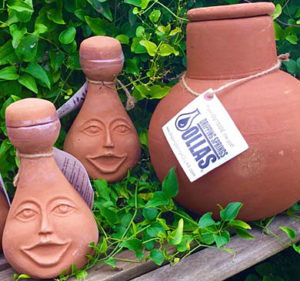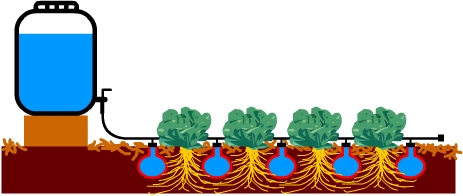
This is the quart size and the 2.9 gallon size ollas.
What is an Olla?
An olla (pronounced oh-yah) is a handmade low fired unglazed terracotta clay pot used as an ancient method of drip irrigation for container gardening or ground applications. Ancient agrarian cultures living in or near desert regions have used olla irrigation methods for millennia. Thought to have originated in Northern Africa and brought to the Americas by the conquistadors, research has also found ollas used in China over 4000 years ago.
Instead of planting in the Olla, you plant around it. The plant roots will proliferate around the moist clay jar, intercepting water before it can move through the soil by capillary action. This water intercepted by plant roots will then be used in the plant transpiration stream. This results in almost 100% of applied irrigation water being absorbed by the plants. Ollas virtually eliminate the runoff and evaporation common in modern irrigation systems, allowing the plant to absorb nearly 100 percent of water. In places with water conservation ordinances, ollas can help maintain a steady flow of water to plants because they dramatically reduce the need to water.
Ollas work well in small urban gardens, square foot gardens, raised planters and large containers. Each large Olla holds about 2.9 gallons of water, and can irrigate up to 18 inches in all directions. Actually an 18 inch radius is only the official rating, I’ve found that Ollas do a great job of keeping my 4′ x 4′ beds watered (that translates to a 24 inch radius).
Olla plantings should be planted in clusters to maximize water use efficiency. While the planting group may be of one plant type, mixtures of grasses, annuals, biennials, and perennials may also be planted around a single buried olla. Mixtures of plant types may be used to create a more natural landscape. The olla clusters may themselves be clustered to create more expansive or linear plantings.
To modernize these ancient irrigation systems, the jars may be recharged by a drip irrigation system, timed and sized to replace water lost from the ollas. Recharge of ollas may be done daily, or as frequently as allowed by water conservation ordinances.
4″ Quart Size
12″ 2.9 Gallon Size
How to Use an Olla:
1. Bury the Olla in soil leaving the neck exposed.
2. Plant seeds or plants within 2” – 5” radius based on olla size.
3. Fill the Olla with water and let it do the work.
Q: How often does an Olla need to be filled with water?
A: Depending on factors such as the plant’s water needs, soil type, time of year, and environment Ollas may need filling weekly or every couple of days. Always check the moisture level of the soil before refilling because an empty Olla doesn’t necessarily mean the plant needs more watering.
Q: What size Olla should I use?
A: As a general guide, smaller Ollas are good for container gardening or large pots . The larger Ollas are good for larger containers or outside ground applications. The general rule of thumb when selecting an olla for a particular pot or space, is to keep in mind that the water seeps out approximately the radius of the olla; the larger the space, the bigger the olla you will need. A plant’s water needs should also determine the Olla size (tomatoes and melons and other high water plants need a larger Olla)
When Ollas are used properly:
Ollas are easy to install.
If you can dig a hole you can install an Olla.
Ollas save water.
In Olla irrigation, plants are watered at the root, so no water is lost to evaporation. Ollas can save 50% to 70% of the water typically used to grow garden plants, like tomatoes, beans and flowers.
Ollas save money.
In Tucson, Arizona, Ollas can reduce water usage, and in turn lower water bills during the dry seasons.
Ollas water plants so you don’t have to.
Ollas liberate gardeners from having to water every day. In fact, some claim refilling Ollas as little as once a week.
Ollas can fertilize.
You can add an organic liquid fertilizer directly to an Olla to slowly feed the surrounding plants.
Ollas are non-toxic.
Ollas are made of 100% natural Tecate clay, and they contain no paint or glaze. Ollas are free from the BPA found in plastics.


